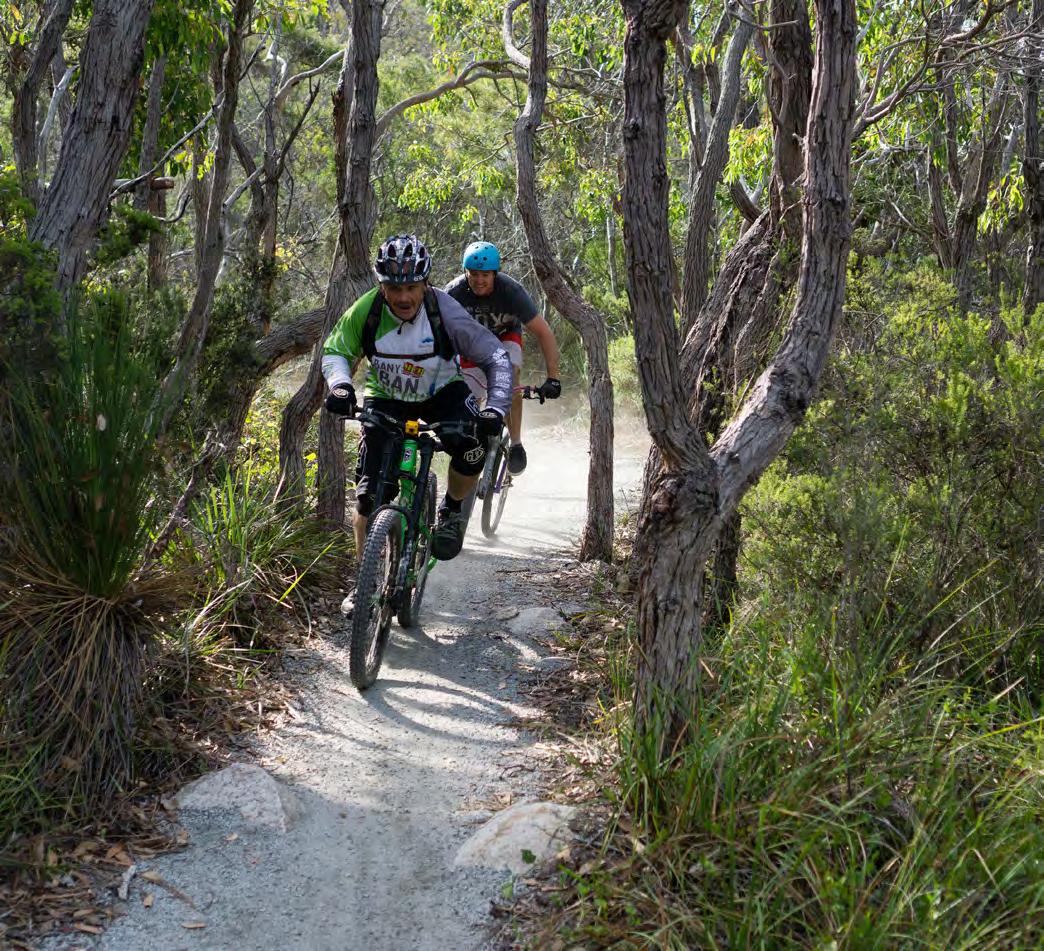
14 minute read
FACILITIES PROVISIONS
CREATING VARIETY
The recommendations within this report are directed at servicing the Shire of Esperance residents first, but at the same time creating facilities that are exciting, create a desire for continual use and are an attractive recreational activity for visitors.
Distributing facilities across the townsite will create variety and provide a differing challenge and experience across the town. Depending on the level of investment, there are opportunities to design and construct facilities that do not just meet growing demand, but also encourage new users to participate.
Challenge Parks are the most rewarding for the user and generally the most successful facility. Multi-disciplinary sites allow for introductory experiences and skills progression. Alternatively, a single discipline community facility is well placed with non-cycling activities to provide an alternative experience whilst other family members are participating in activities such as playparks and skate parks.

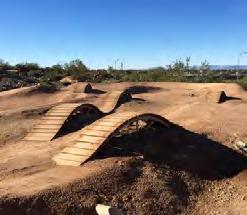
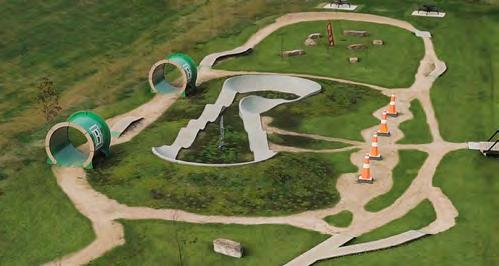

COMMUNITY
Community facilities are designed to service the community in the immediate vicinity or are supplementary to existing experiences offered at a site. They are small scale, minimal budget projects that create opportunity for introductory experiences and skills development for beginners.
LOCAL
A local level facility is intended to service the town of Esperance residents. Users may travel within the town to access the facility. Facilities incorporate basic design, simple detail and are value for money. They generally should allow for skills development for beginners and intermediate riders. Local facilities should be constructed next to existing infrastructure and recreation spaces and are capable of holding small local events, competitions and workshops.
REGIONAL
A regional level facility will be attractive to a wider market and will attract users from outside the immediate area. Additionally, these facilities will provide a greater level of satisfaction and desire to return to the site for local residents. These facilities incorporate more technical design elements, increased detail and will be of varying greater cost depending on technical features and supporting infrastructure. Development around existing supporting infrastructure greatly reduces the cost of regional facilities. There will be opportunity to host larger events, competitions and workshops and they spaces will become thriving community spaces.
STATE
State level facilities capture a much broader market, with individuals travelling great distances to participate. These facilities will attract all user groups from beginners and new participants through to elite riders. Significant capital expenditure is required to develop a State level facility, but there are major opportunities for return on investment. Competitions will draw spectator crowds, create opportunity for facility and equipment hire. State facilities also provide many opportunities for private enterprise in areas such as hospitality, coaching and private sporting clubs.
State facilities require a significant investment in supporting infrastructure such as car parking, ablutions and shower facilities, food and beverage; therefore, require a significant parcel of land.
It is recognised that the topography and land availability within the Shire of Esperance does not suit the development of State facilities. Table 8. Desired site facilities
KEY REQUIREMENTS
Ablutions
Changing facilities and showers
Drinking water
Designated emergency access
Designated spectator viewing and seating
Food and beverage outlets
Lighting
Parking and drop-off
Proximity to major community centre
Public transport access
Rubbish bins
Shelter/ shade COMMUNITY LOCAL REGIONAL STATE

In order to assess the suitability and the appropriateness of cycling facilties within the Shire of Esperance, it is important that a sound understanding of the potential facilities is established. Within urban interface sites there are a range of facilities that can be developed including; Bike Playparks, BMX tracks, Jump Tracks, Pump Tracks, Learn to Ride Tracks and Skills Tracks. Where there is appropriate land available longer purpose built mountain bike trails may also be appropriate.
BIKE PLAYGROUND
Bike playgrounds include features such as tunnels, ramps, walls, and balance planks and are designed to suit a more playful riding style, incorporating tricks and highly skilled riding. Typically bike playgrounds have a more urban character, with constructed elements rather than more natural features.
BMX TRACKS
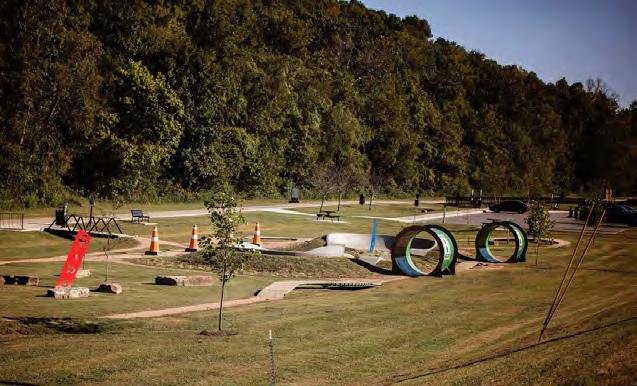
BMX tracks typically consist of a single lap track usually between 300400m, constructed from compacted dirt and asphalt, with a start ramp and features such as tabletops, gap jumps and rhythm sections. BMX racing rewards strength, speed, and bike handling. BMX tracks are typically used in a structured and organised setting rather than unstructured play. A pump track is a 1-3 metre wide track that can be used for bicycle, skateboard, in-line skates and scooter riders to practice skills on a series of features, such as berms and rollers placed in quick succession. Essentially they are scaled down BMX tracks which do not require pedaling. ‘Pump’ refers to the action made by riders pushing down with their arms and legs to manoeuvre the bike or board over features to maintain momentum without pedaling or pushing-off the ground. Typically, tracks can be ridden continuously, and different combinations of features can be linked to provide a varied challenge. Bike handling skills can be transferred to other mountain bike tracks. Well designed pump tracks cater for all abilities, with all features being roll-able for beginners, and allowing for progression to pumping, and even jumping for more advanced riders. Riding a pump track is easy and children are typically comfortable using them within 10-20 minutes.

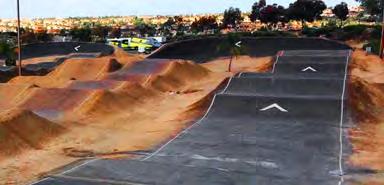
A well designed pump track provides enough challenges to stay attractive for years, because the rollers and berms can be combined and transitioned in different directions, creating opportunity for skilled riders to do jumps and maneuvers. Pump tracks can be made from natural soil, hardened surfaces, wood, fibreglass, concrete or asphalt. Historically pump tracks were constructed from natural soil blends and required significant ongoing maintenance. More recently, world’s best practice is tending toward lower maintenance surfacing techniques and materials, such as asphalt, which are inclusive for a larger user base of wheeled-sports including skateboarding, scooters, in-line skates and non-off road bikes.
JUMP TRACKS
Jump tracks typically feature a series of jumps of various size and technicality in multiple lines. Provision of jump tracks is a vital inclusion allowing for progression for young people through to adults who seek an alternate and often more challenging experience than a pump track. Jumps are developed so that they allow for progression while always keeping safety in mind. Featuring all types of jumps, including tabletops, gaps, step-ups, step-downs and hips, with features linked so riders flow immediately from one to the next. Ideally, a rider will not have to brake between jumps. Well designed jump tracks offer a wide variety of challenges, from easy rollers to big jumps. A diversity of lines will allow riders to build their skills gradually and will create a park that is fun for all abilities. Typically, jump lines are arranged side-by-side in increasing difficulty, all starting at a common roll-in hill and traveling in the same direction. Jump tracks are primarily constructed of soil, however increasingly jump take offs and entire jump lines are being made from hardened surfaces, such as wood, concrete and asphalt. This significantly reduces ongoing maintenance and improves rideability.

Skills tracks feature man-made technical trail features that test the skills of a rider and allow them to try features that they may encounter on trails in the region. Typical features may include log rollovers, log rides, balance planks, rock drops and other technical features. They can also incorporate street features such as rails and wall rides, or freeride stunts like ladder bridges, skinnys, teeters and drops. Importantly all features are built with progression allowing users to start small and build their confidence up to larger features. Successfully executed skills park areas feature a diverse range of materials and can look like well landscaped areas or ‘nature play’ areas with natural features such as timber, logs and rocks.
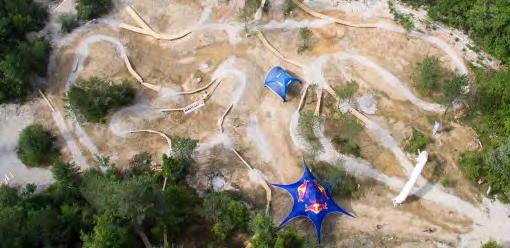
LEARN TO RIDE/ SAFETY TRACKS
Learn to ride, also known as safety tracks, make learning road rules fun for young people on bikes and scooters. A safety track features a miniature road network giving real life experiences while learning essential safety skills. Safety tracks are designed to enable reading traffic signals, crossing railways and school crossings, negotiating roundabouts and gutters, recognising traffic signs and line marking, and cycling on roads or footpaths. Safety tracks are typically constructed using materials and features as they would be encountered in the real world including asphalt and concrete combined with various line marking and road safety signage. To improve the enjoyment of these tracks, features like fuel stations and parking areas can be included for diversity Pump, jump, skills and learn to ride tracks are often integrated into one, larger-scale, seamless facility under the banner of challenge parks. Challenge parks are larger scaled developments featuring multiple bike related facilities and are used to improve riding skills. Their combined facilities provide an excellent entry point into bike riding while offering technical riding features for more advanced riders all within one convenient and safe location.
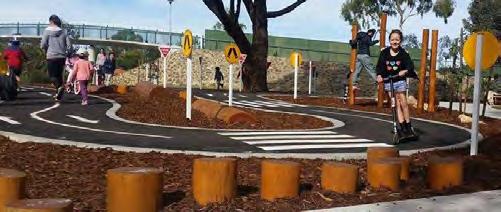
Challenge parks are typically developed with soft landscaping, hardscaping and site improvements turning the area into an aesthetically pleasing community hub and making them suitable for urban interface developments. Due to their offerings, challenge parks also often act as a trailhead or hub for the area’s greater trail networks. Urban interface challenge parks provide significant community benefit with extensive use from youth, but also recreation enthusiasts and, when of significant scale, tourists. Such facilities have proven extremely successful nationally and internationally.
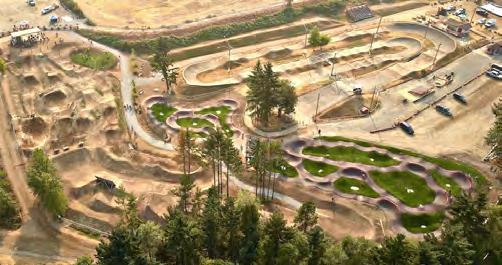
Mountain Bike Trails are purpose built trails in varying terrain. The terrain available will typically dictate the style of trail built. Typically a mountain bike trail or network of trails requires larger areas.
Trail type defines the style of trail and its typical attributes. Different trail types suit different styles of riding and typically each trail type will have a specific kind of mountain bike designed to suit. Different cohorts use different types of trails and all trail types can have varying classifications. Not all environments are suitable to host all trail types and any mountain bike trails developed within the Town of Cambridge will require thorough consideration and planning to ensure long term sustainability.
CROSS COUNTRY
Primarily singletrack, with a combination of climbing and descending trails and natural trail features of varying technicality. They appeal to the majority market and are suitable for timed competitive events. Cross country trails can include cyclo-cross tracks.
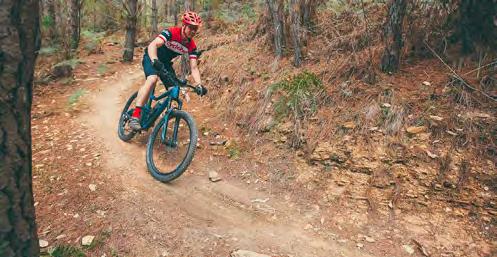
ALL MOUNTAIN
Similar to cross country, primarily singletrack with greater emphasis on technical descents and non-technical climbs. All mountain trails are suitable for timed competitive events.
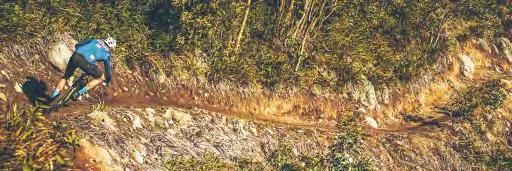
DOWNHILL
Descent only trails with an emphasis on speed and technical challenge. They appeal to more experienced riders; however lower-classification trails are emerging to cater for all experience levels. Downhill trails usually require shuttle uplift to the trailhead via chairlift or vehicle shuttle. These trails are suitable for timed competitive racing. FREERIDE

Descent focused trails with an emphasis on technical challenge and skill development. Trails feature both built and natural technical features with a focus on drops and jumps. Appeals to more experienced riders and caters for competitions judging manoeuvres and skills.
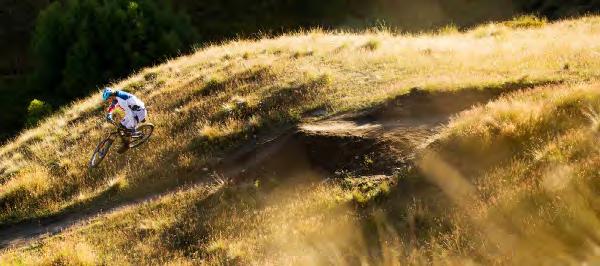
PARK
Built feature environment with emphasis on manoeuvres, skills and progression. Appeals to wide market including youth and can cater for competitions judging aerial manoeuvres. Can include jump and pump tracks and skills parks. Typically, dirt surfaced but can include hardened surfaces.
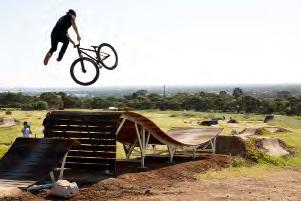
TOURING
Long distance riding on reasonably uniform surface conditions and lower grades. Touring trails are dual direction linear trails or long distance circuits with a focus on reaching a destination. Touring trails can include rail trails, access/fire roads and singletrack. While there is a limited market, touring trails can be ridden in sections making them accessible to all.
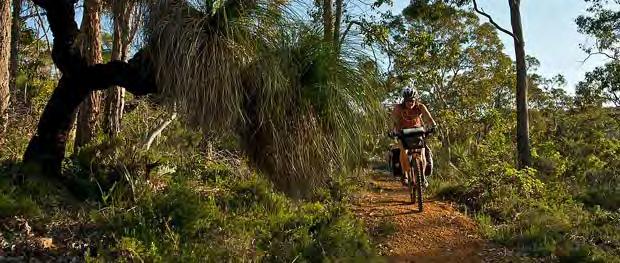
Trails are rated from easiest through to extremely difficult. The difficulty rating system outlines the ratings, which are determined by trail width, tread surface, average trail gradient, maximum trail gradient and natural obstacles and technical trail features. The mountain bike trail classifications in Western Australia are:
Easiest - White Circle (WH)
Wide trails with smooth terrain and low gradients. Surface may be uneven, loose or muddy at times but free from unavoidable obstacles. Recommended for novice riders.
easiest
Easy - Green Circle (GN)
Flowing open trails on firm terrain with gentle gradients. Surface may be uneven, loose or muddy at times. Riders may encounter small rollable obstacles and technical trail features. Recommended for beginner mountain bikers.
easy
MODERATE – Blue SQUARE (BU)
Narrow trail with loose, soft, rocky or slippery sections and hills with short steep sections. Riders will encounter obstacles and technical trail features. Recommended for riders with some technical mountain biking experience.
moderate
Difficult - Black DIAMOND (BL)
Trails with variable surfaces and steep gradients. Riders will encounter large obstacles and technical trail features. Recommended for experienced riders with good technical skill levels.
difficult
EXTREME - DOUBLE BLACK DIAMOND (DB)
Trails may contain highly variable surfaces, very challenging terrain and/ or very steep sections. Riders will encounter unavoidable obstacles and technical trail features. Recommended for very experienced riders with high technical skill levels.
extreme
The addition of recreational cycling facilitates within a community can bring with it addition business opportunities. The following are examples of business opportunities that anecdotally appear to be successful following an increase in cycling across Western Australia communities:
▪ Cycle Tourism ▪ Bike shops/ Hire/ apparel ▪ Local Bike Tours ▪ Hospitality ventures on cycle routes ▪ Social Media presence – knock-on destination marketing
Material selection will determine the ongoing management requirements and user experience. A range of surface treatments exist for various components of recreational cycle facilities. While natural materials can be more affordable and are often desired by the community, they can create significant ongoing management requirements and often fall into disrepair. Conversely hardened materials can be a larger capital investment, but typically see higher participation and far less management requirements.
Ultimately a successful facility often has a range of materials within different facility components. The following table identifies the advantages and disadvantages with each material.
Table 9. Facility construction material advantages and disadvantages
NATURAL EARTH
ADVANTAGES ▪ Low material cost ▪ Involvement of local volunteers ▪ Flexibility (layout and design can be changed any time) ▪ Natural look and feel ▪ Construction possible in bushland ▪ Softer surface MODULAR
▪ Unskilled labour ▪ Relocatable ▪ Suitable for bikes, skateboards, inline skate, scooters ASPHALT
▪ Moderate cost ▪ Low maintenance, durable & sustainable ▪ Low rolling resistance ▪ High traction ▪ Year round usability in any weather ▪ Suitable for bikes, skateboards, inline skate, scooters ▪ Consistent surface quality ▪ Neat look & resistant against vandalism CONCRETE
▪ Durable, sustainable ▪ Low rolling resistance ▪ Year round usability in any weather ▪ Surface structure choice (smooth, grippy, rough) ▪ Colour choice ▪ Usable for bikes, skateboards, inline skate, scooters ▪ Resistant against vandalism ▪ Neat look
DISADVANTAGES ▪ High and frequent maintenance ▪ Only usable in good weather conditions ▪ Suitable for off road bikes only ▪ Susceptible to peak weather damage ▪ Typically falls into disrepair ▪ Often looks dilapidated
MANAGEMENT REQUIREMENTS High
APPROPRIATE MANAGER Volunteer Groups ▪ High cost ▪ Moderate maintenance ▪ Highly susceptible to damage and to vandalism ▪ Low repairability ▪ Damage irreparable ▪ Limited customisation ▪ High material cost ▪ Abrasive surface ▪ Skilled labour ▪ Very high construction cost ▪ High material cost ▪ Abrasive surface ▪ Skilled labour
Medium
Event Promoter Low Low
Local Government / Developer Local Government / Developer
RECOMMENDED FACILITY Dirt Jump landings, Skills Park Relocatable Pump Track Pump Track, Jump Tracks, Safety Track Jump Lips
APPROPRIATE SETTING Bushland Temporary Sites Urban Parkland Urban Parkland
There are a broad range of recreational cycling facilities, with varying complexity, purpose and accompanying price tag. Innovative designs and materiality are ever changing, with more and more Local Governments seeking sustainable recreational cycling facility options.
There are facilities to accommodate all user groups, from complete beginners through to advanced riders, and there is demand for opportunities across the recreational opportunity spectrum. Normally availability of space will dictate the level of development and the span of the facility, but many recreational cycle facilities can be designed to fit within existing built and natural environments, ensuring space is used optimally, the surrounding area is preserved, and user experience is maximised.
The Shire of Esperance has suitable locations and local demand for community, local and regional level facilities. The most sought after experiences are opportunties to further develop skill levels. Currently the experiences in Esperance are not offering skills development opportunties to the mountain biking community, which in turn leads to individuals creating their own facilities.
